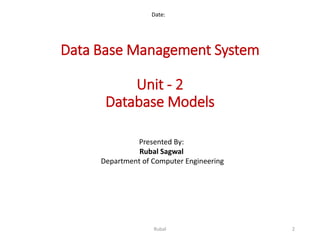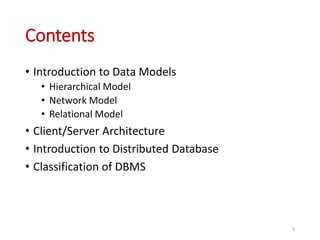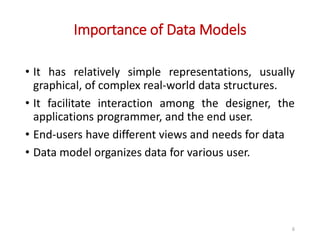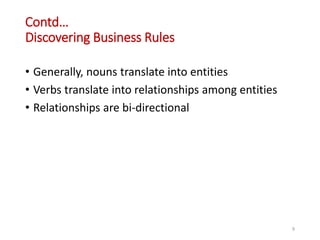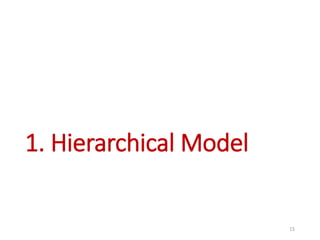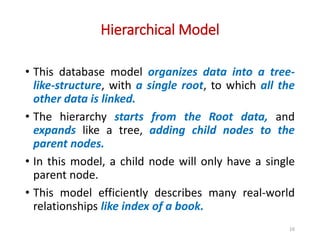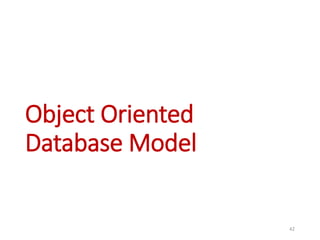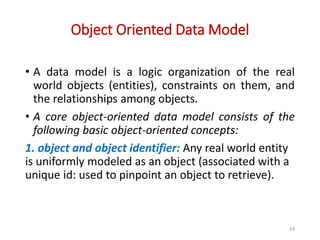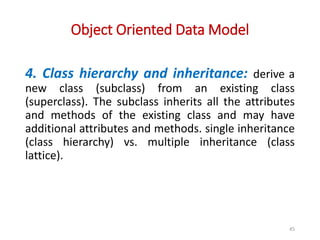Database Models, Client-Server Architecture, Distributed Database and Classification of DBMS
- 1. ADAD 1
- 2. Data Base Management System Unit - 2 Database Models Date: Presented By: Rubal Sagwal Department of Computer Engineering 2Rubal
- 3. Contents • Introduction to Data Models • Hierarchical Model • Network Model • Relational Model • Client/Server Architecture • Introduction to Distributed Database • Classification of DBMS 3
- 5. Introduction • A database can be modeled as: • A collection of entities, • Relationship among entities. • An entity is an object that exists and is distinguishable from other objects. • Example: specific person, company, event, plant 5
- 6. Importance of Data Models • It has relatively simple representations, usually graphical, of complex real-world data structures. • It facilitate interaction among the designer, the applications programmer, and the end user. • End-users have different views and needs for data • Data model organizes data for various user. 6
- 7. Business Rules • Brief, precise, and unambiguous descriptions of a policies, procedures, or principles within a specific organization. • Apply to any organization that stores and uses data to generate information. • Description of operations that help to create and enforce actions within that organization’s environment. 7
- 8. Contd… Business Rules • Must be rendered in writing • Must be kept up to date • Sometimes are external to the organization • Must be easy to understand and widely disseminated • Describe characteristics of the data as viewed by the company 8
- 9. Contd… Discovering Business Rules • Generally, nouns translate into entities • Verbs translate into relationships among entities • Relationships are bi-directional 9
- 10. Data Models Helps In • Standardize company’s view of data • Constitute a communications tool between users and designers • Allow designer to understand the nature, role, and scope of data • Allow designer to understand business processes • Allow designer to develop appropriate relationship participation rules and constraints • Promote creation of an accurate data model 10
- 11. Basic Building Blocks of Data Models • Entity - anything about which data are to be collected and stored • Attribute - a characteristic of an entity • Relationship - describes an association among entities • One-to-many (1:M) relationship • Many-to-many (M:N or M:M) relationship • One-to-one (1:1) relationship • Constraint - a restriction placed on the data 11
- 12. Basic Building Blocks of Data Models • Generally, nouns translate into entities • Verbs translate into relationships among entities • Relationships are bi-directional 12
- 13. Types of Data Models 1. Hierarchical Model 2. Network Model 3. Relational Model 13
- 14. 14
- 16. Hierarchical Model 16 • This database model organizes data into a tree- like-structure, with a single root, to which all the other data is linked. • The hierarchy starts from the Root data, and expands like a tree, adding child nodes to the parent nodes. • In this model, a child node will only have a single parent node. • This model efficiently describes many real-world relationships like index of a book.
- 17. Hierarchical Model 17 • In hierarchical model, data is organised into tree-like structure with one one-to-many (1:M) relationship between two different types of data, • For example • One department can have many courses, many professors and many students. • Each parent can have many children, each child has only one parent. • This model was primarily used by IBM’s Information Management Systems in the 60s and 70s, but they are rarely seen today due to certain operational inefficiencies.
- 19. Hierarchical Model 19 • Advantages: • Conceptual simplicity • Data independence • Efficiency dealing with a large database • Disadvantages: • Complex implementation • Difficult to manage and lack of standards • Lacks structural independence • Applications programming and use complexity • Implementation limitations (no M:N relationship)
- 21. Network Model 21 • The network model has greater flexibility than the hierarchical model for handling complex spatial relationships. • Objective of network model is to separate data structure from physical storage, eliminate unnecessary duplication of data with associated errors and costs. • The Network Database Model was created for three main purposes : • representing a complex data relationship more effectively • improving database performance • imposing a database standard
- 22. Network Model 22
- 23. Network Model • Resembles hierarchical model • Collection of records in 1:M relationships • Consist of: • Relationship • Composed of at least two record types • Owner • Equivalent to the hierarchical model’s parent • Member • Equivalent to the hierarchical model’s child 23
- 24. Network Model • Major characteristic of this database model is that it comprises of at least two record types ; the owner & the member. • An owner is a record type equivalent to the parent type in the hierarchal database model, and the member record type resembles the child type in the hierarchal model. • The network model contains logical information such as connectivity relationships among nodes and links, directions of links 24
- 25. Network Model – Key Terms • A node represents an object. • A link represents a relationship between two nodes. Within a directed network, any link can be bidirected (that is, able to be traversed either from the start node to the end node or from the end node to the start node) or undirected (that is, able to be traversed only from the start node to the end node). • A path is an alternating sequence of nodes and links, beginning and ending with nodes. 25
- 26. Network Model – Network Hierarchy • A network hierarchy enables us to represent a network with multiple levels of abstraction by assigning a hierarchy level to each node. • Nodes at adjacent levels of a network hierarchy have parent-child relationships. • Each node at the higher level can be the parent node for one or more nodes at the lower level. • Each node at the lower level can be a child node of one node at the higher level. • Sibling nodes are nodes that have the same parent node. 26
- 27. Network Model • Advantages: • Simplicity : The network model is conceptually simple and easy to design. • Ability to handle more relationship types : The network model can handle the one-to-many and many-to-many relationships. • Ease of data access • Disadvantages: • System Complexity : The structure of the network model is very difficult to change. This type of system is very comple. 27
- 29. Relational Model • In this model, data is organized in two- dimensional tables and the relationship is maintained by storing a common field. • This model was introduced by E.F Codd in 1970, and since then it has been the most widely used database model, infact, we can say the only database model used around the world. • The basic structure of data in the relational model is tables. All the information related to a particular type is stored in rows of that table. • Hence, tables are also known as relations in relational model. 29
- 31. Relational Model 31 • Relation (file, table) is a two-dimensional table. • Attribute (i.e. field or data item) is a column in the table. • Each column in the table has a unique name within that table. • Each column is homogeneous. Thus the entries in any column are all of the same type (e.g. age, name, employee-number, etc). • Each column has a domain, the set of possible values that can appear in that column. • A Tuple (i.e. record) is a row in the table.
- 33. Client-Server Architecture • The client/server architecture was developed to deal with computing environments in which a large number of PCs, workstations, file servers, printers, data base servers, Web servers, e-mail servers, and other software and equipment are connected via a network. • The idea is to define specialized servers with specific functionalities. 33
- 34. Client-Server Architecture • For example, it is possible to connect a number of PCs or small workstations as clients to a file server that maintains the files of the client machines. Another machine can be designated as a printer server by being connected to various printers; all print requests by the clients are forwarded to this machine. 34
- 35. Client-Server Architecture • A client – in this framework is typically a user machine that provides user interface capabilities and local processing. • When a client requires access to additional functionality— such as database access—that does not exist at that machine, it connects to a server that provides the needed functionality. • A server – is a system containing both hardware and software that can provide services to the client machines, such as file access, printing, archiving, or database access. • In general, some machines install only client software, others only server software, and still others may include both client and server software, 35
- 38. Distributed Database • In a distributed database system, the database is stored on several computers. • The computers in a distributed system communicate with one another through various communication media, such as high-speed networks or telephone lines. • They do not share main memory or disks. The computers in a distributed system may vary in size and function. 38
- 40. Distributed Database 40 • A distributed database is basically a database that is not limited to one system, it is spread over different sites, i.e, on multiple computers or over a network of computers. • A distributed database system is located on various sited that don’t share physical components. This maybe required when a particular database needs to be accessed by various users globally.
- 41. Distributed Database System 41 • Sharing data: The major advantage inbuilding a distributed database system is the provision of an environment where users at one site may be able to access the data residing at other sites. For instance, in a distributed banking system, where each branch stores data related to that branch, it is possible for a user in one branch to access data in another branch. • Availability: If one site fails in a distributed system, the remaining sites may be able to continue operating. In particular, if data items are replicated in several sites, a transaction needing a particular data item may find that item in any of several sites. Thus, the failure of a site does not necessarily imply the shutdown of the system. • Data Recover is easy.
- 43. Object Oriented Data Model 43 • A data model is a logic organization of the real world objects (entities), constraints on them, and the relationships among objects. • A core object-oriented data model consists of the following basic object-oriented concepts: 1. object and object identifier: Any real world entity is uniformly modeled as an object (associated with a unique id: used to pinpoint an object to retrieve).
- 44. Object Oriented Data Model 44 2. Attributes and methods: every object has a state (the set of values for the attributes of the object) and a behavior (the set of methods - program code - which operate on the state of the object). The state and behavior encapsulated in an object are accessed or invoked from outside the object only through explicit message passing. 3. class: a means of grouping all the objects which share the same set of attributes and methods. An object must belong to only one class as an instance of that class (instance-of relationship). A class is similar to an abstract data type. A class may also be primitive (no attributes), e.g., integer, string, Boolean.
- 45. Object Oriented Data Model 45 4. Class hierarchy and inheritance: derive a new class (subclass) from an existing class (superclass). The subclass inherits all the attributes and methods of the existing class and may have additional attributes and methods. single inheritance (class hierarchy) vs. multiple inheritance (class lattice).
- 46. Object Oriented Data Model 46

